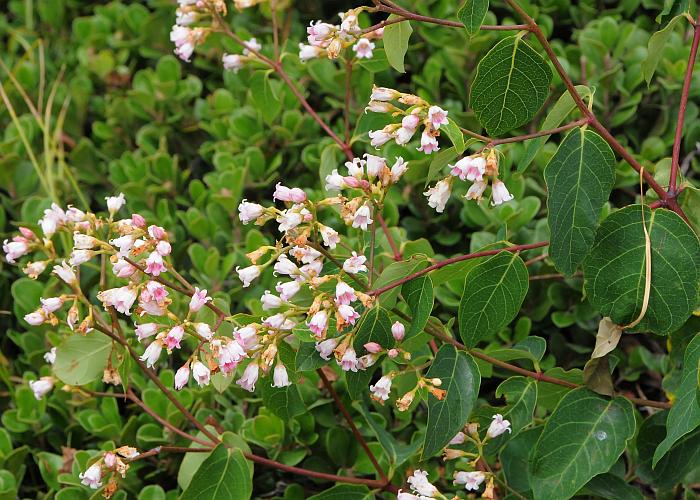Apocynum androsaemifolium L.
Spreading Dogbane

Native
CC = 5
CW = 5
MOC = 27
© SRTurner
Apocynum androsaemifolium L.Spreading Dogbane | |
 |
Native CC = 5 CW = 5 MOC = 27 |
© SRTurner |
|
Family - Apocynaceae Habit - Perennial herb, sometimes woody at base, with milky sap. Stems - Ascending to erect, to 1.5 m, branched, glabrous, often glaucous, terete. Leaves - Opposite, occasionally some subopposite or alternate, short-petiolate or sessile, the lower leaves typically drooping. Petioles to 5 mm. Leaf blades ovate to elliptic, to 9 cm, entire, the upper surface glabrous, the lower surface usually sparsely pubescent, rounded to angled and often mucronate at the tip, often somewhat asymmetrical at the rounded base.
Inflorescences - Terminal or axillary, branched loose clusters of few to many flowers. Flowers sweetly fragrant. Peduncles and pedicels glabrous. Peduncles to 4 cm long. Pedicels to 4 mm long in flower.
Flowers - Calyces glabrous, the lobes 1.5-2.5 mm long, ovate-triangular. Corollas 5-lobed, bell-shaped, 4-7 mm long, whitish to pink, with pink stripes on the inner surface, the tube 3-4 mm long, usually more than twice as long as the calyx, 4-5 mm wide at the tip, the lobes 2-3 mm long, spreading or recurved. Stamens 5, curving inward to form a cone over the stigma, the filaments 0.8-1.1 mm long, hairy. Anthers 2.5-3.2 mm long. Nectar glands 5, green, alternating with stamens. Pistils 2, green, glabrous. Styles 0.7-1.0 mm long, the ovoid stigma about 1 mm long.
Fruits - Follicles to 9 cm, pendent, slender, straight. Seeds numerous, 2-3 mm long, narrowly cylindrical, somewhat tapered toward the base, with a tuft of hairs at the truncate tip.
Flowering - May - July. Habitat - Dry open rocky woods, thickets, roadsides. Origin - Native to the U.S. Other info. - This species is scattered and not very common in Missouri. It is far more common in the upper Midwest and in the western half of the U.S. When blooming it is easy to identify by its distinctive flowers, which have recurved lobes and pink internal stripes. The species has been subdivided, and according to this classification Missouri plants would be referable to var. androsaemifolium. Photographs taken at Pictured Rocks National Seashore, MI., 7-12-02 (DETenaglia); also in Larimer County, CO, 7-10-2014, 7-30-2017, 6-23-2018, and 7-9-2019, and near Liberty Lake, Spokane County, WA, 7-24-2021 (SRTurner). |